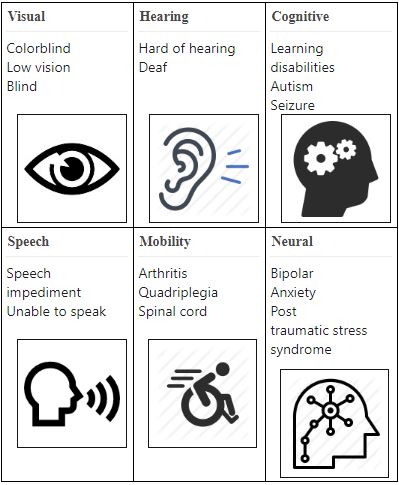Technology Makes Accessible Possible in Inclusive Classrooms
If you are an innovative educator, than you know that you serve students with varying abilities and learning differences.
If you are an innovative educator, than you know that you serve students with varying abilities and learning differences. Some are visible, like a person in a wheelchair. Some may not be visible such as a person who is colorblind. Some have varying levels of visibility such as someone on the autism spectrum. Some may progress and become more visible over time or as you get to know the student. There are also those who have multiple disabilities which can affect areas like cognition, speech, and mobility. Disability can come in a wide variety of forms, both visible and invisible and can affect any of us at any time.
Here is a breakdown of areas where learners may need support:

Conventional Approaches Weren't Inclusive
In the traditional classroom of the 20th century, for the most part, students affected by learning differences often had no special accommodations. Those that did may have had to be separated from other students receiving intense, often intrusive interventions.
Ways Technology Makes Accessible Possible
Today, in the modern classroom, this no longer has to be the case for students. Technology makes accessible possible for so many more students than ever before. Once content is digital students can
[Alexa, Google Home, or HomePod: Guide to Determining What's Right For You]
Tools and ideas to transform education. Sign up below.
- Have the content read to them
- Change the colors
- Change the contrast
- Turn content into pictures
- Make math visual
- Add captions to videos
- Speak and have their speech turned into text
- Turn text into Braille
- See information in one language and easily turn it into a chosen language and then have it read to them
- Type content and hear it read back to them to ensure it makes sense
- Receive assistance with spelling and grammar
- Use the keyboard only without a mouse to navigate
- Have a screen reader navigate the page
- Access text at their reading level
- Play soothing music to help a student focus or relieve anxiety
Instead of the prohibitive costs associated with accessibility devices in the past, all of this is simply built into many browsers and operating systems. There is no additional cost. As the costs of devices decreases they are now less expensive than buying paper, pencils, notebooks, calculators, printers, rulers, and all the other tools.
For that same few hundred dollars per year, at what is often less then the cost of low tech, schools that understand the power of an inclusive classroom, can ensure every student has an accessibility hub available to them. They'll also train their teachers how to use these tools and ensure all students devices are set up for optimum learning and creation.
Your Turn
How do you provide an inclusive classroom? In what ways do you ensure all your students have customized their devices to ensure all accessibility needs are met? How do you create content and material that is accessible to all learners (i.e. using alt text, headings, proper links)? How are you empowering students to know and use the tools that make learning most accessible to them?
Lisa Nielsen (@InnovativeEdu) has worked as a public-school educator and administrator since 1997. She is a prolific writer best known for her award-winning blog, The Innovative Educator. Nielsen is the author of several booksand her writing has been featured in media outlets such as The New York Times,The Wall Street Journal, Tech&Learning, and T.H.E. Journal.
Lisa Nielsen (@InnovativeEdu) has worked as a public-school educator and administrator since 1997. She is a prolific writer best known for her award-winning blog, The Innovative Educator. Nielsen is the author of several books and her writing has been featured in media outlets such as The New York Times, The Wall Street Journal, and Tech & Learning.
Disclaimer: The information shared here is strictly that of the author and does not reflect the opinions or endorsement of her employer.
